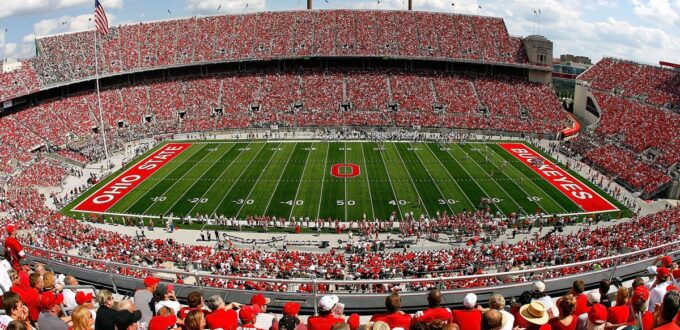COLUMBUS, OH – SEPTEMBER 06: A general view of Ohio Stadium during the game between the Ohio State … [+] Buckeyes and the Ohio Bobcats on September 6, 2008 in Columbus, Ohio.
Big changes are underway that will change the face of college sports in the United States. If the transformation is left up to the market, the courts and a dysfunctional NCAA, the role of intercollegiate athletics in complementing higher education and providing cultural entertainment for sports fans will be challenged. Although entrenched in policy rigor mortis, Congress needs to step up and assert policy to preserve intercollegiate athletics as an integral part of educating athletes and to identify the public purpose that we seek for college sports to play in our society.
The current tumult erupted on July 1, 2021, when the commercial space for college athletes around names, images and likenesses (NIL) was opened by various state laws. Soon thereafter, in the wake of a stunning SCOTUS decision in National Collegiate Athletic Association v. Alston, the NCAA withdrew its detailed, proposed NIL-related guardrails, rules and enforcement requirements. While the NCAA continued to insist that it would prohibit the use of NILs in recruitment, it doesn’t have an effective enforcement apparatus, the financial resources or the will to implement any meaningful regulations.
Athletic directors and coaches have stepped into the breach and begun to lure recruits with claims about how much their players are earning from NIL deals at their respective schools. Prominently, at a high school coaches’ convention, Alabama head football coach Nick Saban announced that his starting quarterback would be earning almost $1 million in endorsements. Some schools, like USC, have announced partnerships with local studios to provide NIL branding pitches for its athletes.
Athletic departments are entering into co-licensing (schools granting athletes permission to use their logos/marks/color schemes, etc., for third-party agreements), group licensing (schools and groups of athletes entering into respective agreements with the same sponsor to promote the same product, such as video games, bobbleheads or trading cards, using both the school’s logos/marks/color schemes and athlete’s name and image, with both schools and athletes separately profiting from their respective agreements), and other imaginative sponsorship agreements.
The Brandr Group has been on a tear doing group licensing deals with college football teams. The UNC-Brandr group-licensing agreement grants Brandr the right to use the UNC name/logo in conjunction with any UNC/athlete NIL sponsorship proposal. Similarly, UNC athletes and the school get royalties from co-branded products such as sales of jerseys with athletes’ names on the back. Michigan State, Texas, Indiana, Alabama, Ohio State, Appalachian State, Florida, LSU, Nebraska, Miami, Texas Tech, and Oklahoma State quickly followed suit with Brandr deals.
Opendorse reports that, based on an analysis of the first two months of available agreements, 60% of total compensation is going to football players, and 79.8% of total compensation is going to male athletes. For example, at Michigan State, men’s basketball and football players—133 of them—will receive $500 monthly for promoting United Wholesale Mortgage, a company owned by a former MSU basketball player. At the University of Miami, everyone on the football team will receive $500 a month for promoting a mixed martial arts gym, and every basketball player will receive $500 a month from Yummy Crypto, a new cryptocurrency company for promoting its product through social media and personal appearance. Not to be outdone by its ACC conference rivals, Florida State will see every football player receive $500 during the first month of the season, with possible extensions, from Yummy Crypto for similar promotions. Meanwhile, every Georgia Tech football player will receive silk pajamas, yellow jackets, prepaid debit cards worth $404 and a streaming device from TiVo in exchange for promoting TiVo on social media.
No activity has raised more doubts in the athlete recruitment space than the birth of “NIL collectives.” Instead of traditional booster clubs that raise money to donate to the athletic department, similar third-party entities are being created by the institution’s boosters, fans, sponsors and other representatives of athletics interest to act as a conduit to pay athletes for their NIL services.
All this adds up to the following. The combination of differing state NIL legislation, the NCAA’s policies and enforcement in limbo, the threat of court action and the ponderous and moribund Congress has created a vacuum into which the marketplace has stepped. Creeping pay-for-play is here. The roughly 25% of Power Five athletic department revenue that used to come from donors and corporate sponsors is now finding its way, often circuitously and surreptitiously, to the athletes in a surrogate labor market.
The surrogate labor market enables schools to attract recruits in the conventional way—to compete with one another by offering the potential for higher income. This means that schools no longer have to rely entirely on recruiting athletes indirectly—via elaborate facilities, well-known coaches, first-class travel, etc. Of course, facilities often come with 30 years of debt service and coaches with five-to-ten-year contracts, so these stratospheric costs will be around for a while. In the meantime, college athletic department budgets, already approaching a median annual deficit of $20 million in FBS, will soar upward, and institutions’ central educational budgets will suffer. Some college athletes will earn five-to-six-figure NIL incomes, but the vast majority will earn something between nothing and a pittance while spending countless hours attempting to hone their social media skills.
Public-policy makers can take a back seat and let this chaotic process play out. Or they can fashion a deliberate process via a congressional commission to study what forms of intercollegiate athletic competition can best complement our system of higher education as well as retain the cultural entertainment role of college sports. At least Congress can give it the old college try.

No Comments Yet